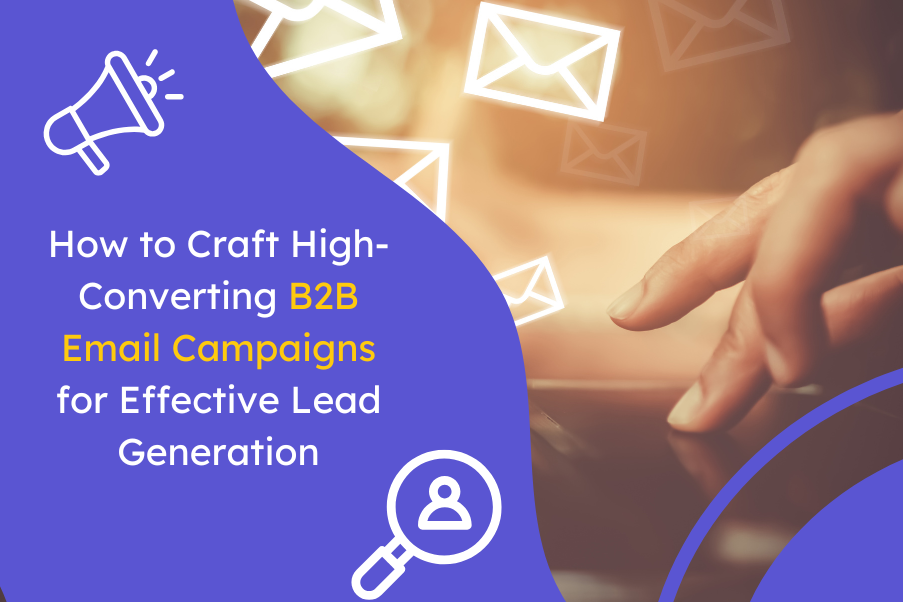In the fast-paced world of B2B Lead Generation, achieving seamless Sales and Marketing Alignment is not just beneficial, it’s essential. Many companies struggle with disconnects between these two critical teams, resulting in inefficiencies, poor lead quality, and lost revenue opportunities. However, when Marketing and Sales Collaboration is well-executed, it creates a unified Marketing Strategy that drives Lead Conversion, optimizes the Sales Process, and accelerates business growth.
This blog explores the significance of Sales and Marketing Integration, its benefits, and actionable strategies to ensure a collaborative approach that fuels successful B2B Lead Generation.
The Importance of Sales and Marketing Alignment
Effective Sales and Marketing Integration is one of the most influential factors in driving business growth. When these teams function within a unified Sales Process, organizations experience substantial improvements in:
- Marketing Return on Investment (ROI)
- Sales efficiency and performance
- Revenue growth and profitability
Despite these advantages, many businesses face challenges due to siloed operations. Marketing Strategy efforts may not always align with sales objectives, and sales teams may struggle with leads that have not been adequately nurtured. When marketing creates content without clear sales objectives, or when sales teams pursue leads that are not effectively nurtured, overall performance suffers. The misalignment leads to inconsistent messaging, wasted resources, and lost revenue opportunities.
By bridging this gap through Marketing and Sales Collaboration, organizations can optimize their Lead Conversion rates and overall success. An integrated approach ensures that marketing efforts generate high-quality leads, while sales teams effectively nurture and convert them into customers.
Benefits of Sales and Marketing Collaboration
1. Improved Key Performance Metrics (KPIs)
When Sales and Marketing Alignment is achieved, performance indicators such as marketing-generated revenue, sales win rates, and customer retention significantly improve. Sales and marketing integration ensures that both teams capitalize on shared expertise, maintain consistent messaging, and enhance the overall Sales Process.
For example, a company that aligns marketing campaigns with sales outreach efforts will experience higher engagement rates, improved lead nurturing, and ultimately better conversion rates. By refining individual KPIs—such as lowering customer churn—organizations can directly contribute to revenue growth, creating a continuous cycle of business improvement.
2. Establishing a Continuous Feedback Loop
A well-integrated marketing strategy fosters a dynamic feedback loop, allowing teams to share insights, refine approaches, and improve lead quality. Sales teams can provide real-time feedback on the effectiveness of marketing campaigns, while marketing can refine messaging based on sales performance data. This iterative process enhances overall revenue generation and ensures continuous optimization of B2B Lead Generation efforts.
For instance, if sales teams notice that a particular set of leads consistently fails to convert, they can relay this information to marketing, prompting adjustments in targeting strategies and content development. This creates a cycle of improvement that strengthens the overall business strategy.
3. Aligning Goals and Objectives
Clear communication and coordination between sales and marketing teams ensure that their goals remain synchronized. While sales teams focus on closing deals, marketing teams work on demand generation and nurturing leads. A collaborative approach maximizes effectiveness and ensures a seamless Sales Process.
By establishing shared objectives, companies can eliminate conflicting priorities and create a more cohesive approach to lead generation. When both teams work toward the same revenue-driven goals, they enhance efficiency and ensure a smoother customer journey.
4. Strengthening Workplace Collaboration
Cross-departmental cooperation builds a culture of teamwork and shared success. Employees become more engaged and motivated when working toward common business goals, leading to a more productive and results-driven environment.
Encouraging collaboration between marketing and sales teams fosters trust and mutual respect, making it easier to tackle challenges and drive collective success. A well-aligned workplace culture leads to improved morale, lower employee turnover, and stronger overall business performance.
Strategies to Align Sales and Marketing for Lead Generation
A well-coordinated sales and marketing alignment strategy is critical for optimizing B2B lead generation and driving business growth. By fostering marketing and sales collaboration, businesses can ensure a smooth transition of leads through the sales process, improving lead conversion rates and overall efficiency. Here are key strategies to enhance sales and marketing integration for more effective lead generation:
1. Establish Shared Goals and KPIs
To create a unified approach, sales and marketing teams must define common goals and success metrics. Clear KPIs ensure both departments work toward the same objectives and provide measurable benchmarks to track progress.
- Marketing Qualified Leads (MQLs) vs. Sales Qualified Leads (SQLs): Marketing generates MQLs based on engagement, while sales identifies SQLs as leads ready for direct outreach. Defining clear criteria for these stages prevents miscommunication and ensures high-quality leads reach the sales team.
- Lead-to-Customer Conversion Rates: Tracking the percentage of leads that convert into paying customers helps both teams evaluate the effectiveness of their efforts. Low conversion rates may indicate gaps in lead nurturing, sales follow-ups, or targeting accuracy.
- Customer Acquisition Cost (CAC) and Customer Lifetime Value (CLV): Balancing CAC with CLV ensures that sales and marketing efforts focus on attracting and retaining high-value customers.
By setting these shared goals, organizations can create a cohesive marketing strategy that maximizes lead quality and conversion potential.
2. Implement a Seamless Communication Framework
Effective marketing and sales collaboration requires open and continuous communication. Establishing structured channels ensures both teams stay aligned and informed.
- Regular Alignment Meetings: Schedule weekly or biweekly meetings to discuss campaign performance, lead quality, and challenges. These discussions provide valuable insights and allow both teams to refine their approach in real-time.
- Utilization of Collaboration Tools: Use platforms like Slack, Asana, Trello, or Microsoft Teams to facilitate real-time updates, content sharing, and project management. These tools help maintain transparency and efficiency.
- Develop a Service Level Agreement (SLA): An SLA outlines specific responsibilities for both teams, setting expectations for lead generation, follow-up times, and handoff procedures.
A structured communication framework minimizes misunderstandings and ensures both teams work efficiently towards shared objectives.
3. Leverage CRM and Marketing Automation Tools
Technology plays a crucial role in sales and marketing integration. By integrating Customer Relationship Management (CRM) and marketing automation tools, businesses can streamline lead tracking, nurturing, and conversion.
- Use Platforms like HubSpot, Salesforce, or Marketo: These tools centralize customer data, track interactions, and provide valuable insights into lead behavior.
- Automate Lead Nurturing Campaigns: Marketing automation enables businesses to send personalized email sequences, segment leads based on engagement, and score leads before passing them to sales, improving conversion rates.
By integrating CRM and automation, businesses can create a seamless lead management system that enhances efficiency and effectiveness.
4. Define and Refine the Ideal Customer Profile (ICP)
A well-defined Ideal Customer Profile (ICP) ensures that sales and marketing efforts are targeted toward the most valuable prospects. Misalignment in targeting can lead to wasted efforts and poor conversion rates.
- Conduct Joint Research to Identify High-Value Prospects: Analyze existing customer data to determine the characteristics of high-value customers, including industry, company size, pain points, and decision-making processes.
- Develop Targeted Marketing Content: Once the ICP is established, marketing can create content that speaks directly to customer challenges, while sales teams tailor their pitches accordingly.
Refining the ICP ensures that sales and marketing efforts are strategically focused, reducing wasted resources and improving lead conversion rates.
5. Create a Feedback Loop for Continuous Improvement
To maintain alignment, businesses need an ongoing process for evaluating and improving sales and marketing alignment strategies. A structured feedback loop allows both teams to adapt based on real-world performance.
- Sales Teams Provide Insights on Lead Quality and Content Effectiveness: Sales professionals can share feedback on whether marketing-generated leads are relevant and well-prepared for conversion.
- Marketing Teams Adjust Strategies Based on Sales Feedback: Marketing should analyze performance data and feedback from sales to refine content, messaging, and targeting strategies.
By fostering a culture of continuous improvement, organizations can ensure their B2B lead generation strategies remain effective and adaptable to changing market dynamics.
Role of Technology in Sales and Marketing Integration
1. Marketing Automation and CRM Tools
Marketing automation and CRM tools help sales and marketing teams stay aligned by streamlining communication and data sharing. Automation platforms like HubSpot and Marketo enable marketing teams to nurture leads through targeted campaigns, ensuring prospects are engaged before being handed off to sales. CRM systems such as Salesforce and Zoho CRM provide sales teams with real-time access to lead history, interactions, and behavioral insights, allowing them to personalize their approach and close deals more effectively. By integrating these tools, businesses create a seamless transition between marketing and sales, ensuring consistent messaging, improving efficiency, and enhancing the overall customer experience.
2. AI-Driven Insights for Personalized Engagement
AI-powered insights help sales teams focus on high-intent prospects by analyzing customer behavior and engagement patterns. By segmenting audiences based on browsing habits, past purchases, and interactions, AI enables businesses to prioritize leads most likely to convert. AI-driven chatbots further enhance customer experience by providing instant support and guiding potential buyers through their journey. This level of personalization not only improves engagement but also optimizes resource allocation, reducing time spent on unqualified leads and increasing overall sales efficiency.
3. Data Analytics for Tracking and Optimizing Strategies
Data analytics provides real-time insights into campaign performance, allowing businesses to measure success and optimize strategies. By tracking customer interactions and engagement patterns, marketing teams can refine their approach, while sales teams adapt based on behavioral trends. Tools like Google Analytics and Adobe Analytics enable data-driven decisions, ensuring resources are allocated effectively and minimizing wasted efforts on ineffective strategies. This continuous feedback loop enhances performance and maximizes return on investment.
Conclusion
In today’s competitive B2B landscape, Sales and Marketing Alignment is the key to unlocking greater efficiency, higher lead conversion rates, and sustained business growth. By fostering seamless Marketing and Sales Collaboration, leveraging technology, and maintaining a continuous feedback loop, businesses can optimize their Sales Process and maximize ROI. When both teams work towards a unified Marketing Strategy, the results are clear: stronger customer relationships, reduced acquisition costs, and increased revenue.
If you’re looking to streamline your B2B Lead Generation efforts with expert-backed strategies and cutting-edge tools, PMG B2B can help. Our proven solutions ensure that your Sales and Marketing Integration drives real results.




